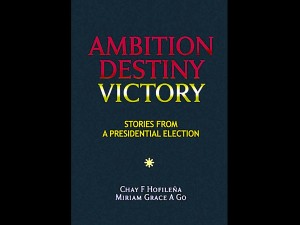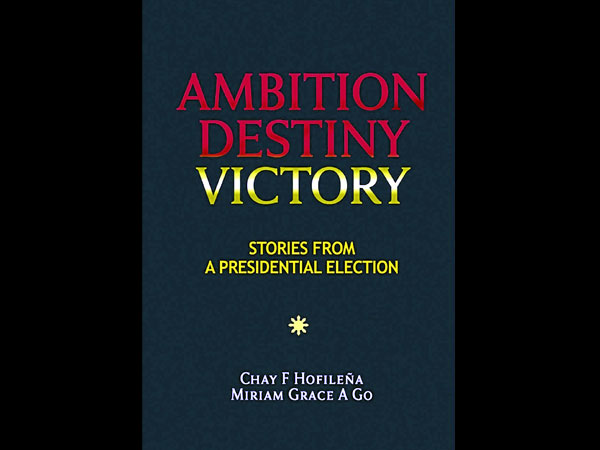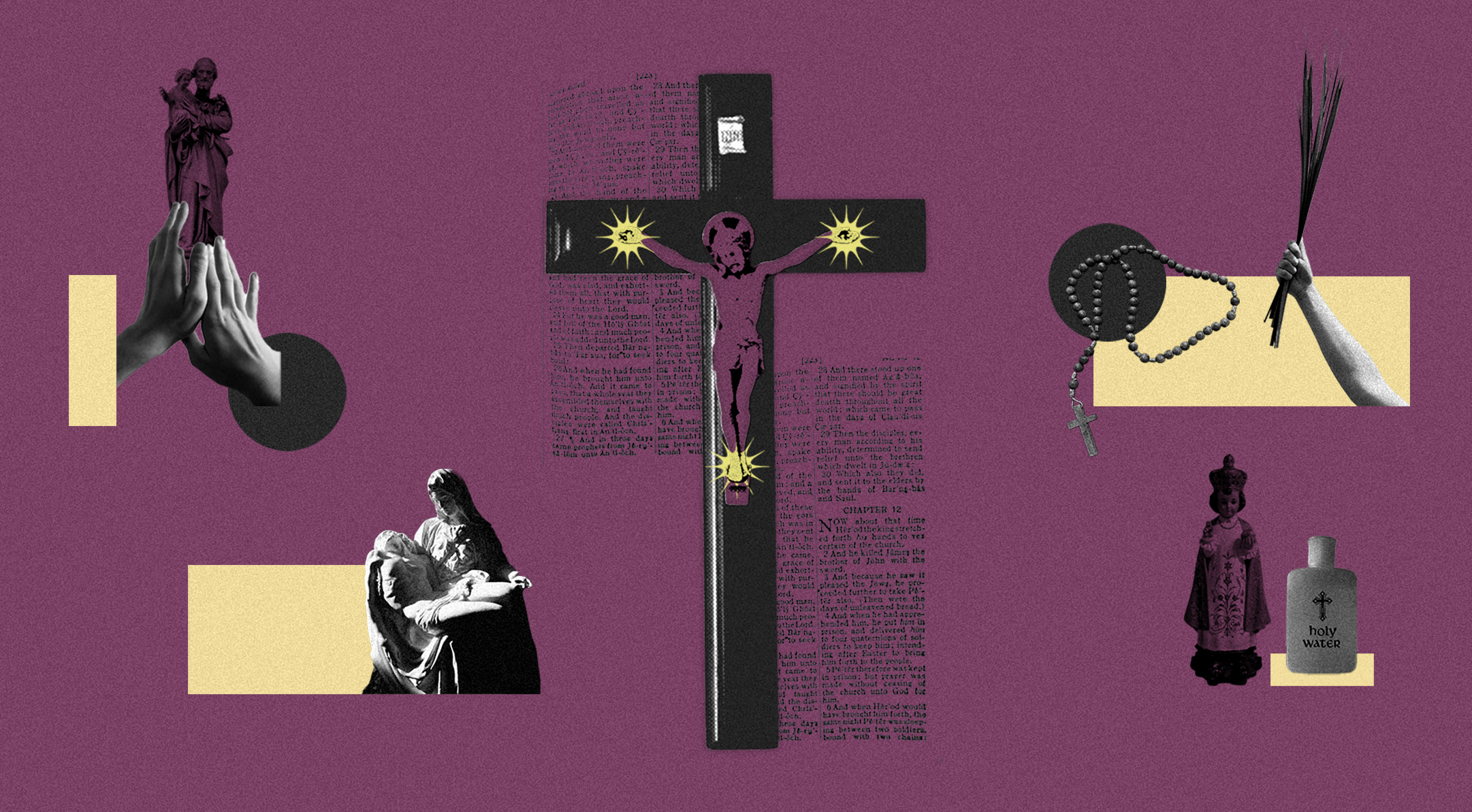
When we reflect on the historic events of the May 2010 elections, they seem like a single, blinding burst of light, so strong that it eradicated whatever came before it and obscured what happened immediately after.
In truth, that game-changing burst of light is made up of countless crucial decisions made behind the scenes, an endless cycle of wheeling and dealing that characterize national elections in the Philippines. The campaign dynamics that eventually saw Benigno Simeon “Noynoy” Aquino III elected as the new president of the Republic of the Philippines are recounted in painstaking and insightful detail in a new book from Cacho Publishing House.
“Ambition Destiny Victory: Stories from a Presidential Election” by seasoned investigative journalists Chay F. Hofileña and Miriam Grace A. Go is a careful and exhaustive parsing of the breathtaking events and the personalities behind them that led up to the 2010 elections.
The book features a familiar cast in familiar roles: the reluctant heir Noynoy Aquino, the ambitious businessman Manuel “Manny” B. Villar, the pardoned former President Joseph Estrada and the young technocrat Gilbert “Gibo” Teodoro.
What “Ambition Destiny Victory” shows us is that the roles did not always fit the actors. The chapter on Aquino, “Torchbearer,” proves that Aquino was far more reluctant than he was perceived to be. His mother Corazon Aquino’s death on Aug. 1, 2009 triggered a wave of events that would pull Aquino with it; he was hesitant to join the fray until compelled by the growing clamor for him to run.
The book shows that Aquino’s sisters were very much against him running as well. “Meanwhile, as the so-called ‘yellow forces’ were creating tremendous noise to convince Noynoy to run for president, the Aquino siblings remained extremely lukewarm, if not opposed, to their brother seeking higher office.” This chapter humanizes Aquino thoroughly, exhibiting a candidate who struggled against the daily grind of the campaign.
Also fascinating is the array of forces lined up behind the Aquino candidacy. These forces shifted and changed as the campaign went on. “Torchbearer,” the meatiest portion of the book, goes into a lot of detail regarding the construction of Aquino’s campaign machinery, as well as Manuel “Mar” Roxas’ selfless decision to slide down to the vice presidency slot despite being the Liberal Party’s favorite as standard bearer.
“Ambition Destiny Victory” allows us to peer into almost every nook and cranny of the Aquino campaign and we emerge with the understanding of how powerful public opinion can be, even in the most rarefied of political circles.
What one realizes when reading the chapter on Manny Villar, “The Businessman as Politician,” is how little we knew about the man. Villar had been marching his way up the political ladder ever since his prayer/impeachment speech against Estrada in 2000. As a prominent candidate for the 2010 polls, as the standard-bearer for the Nacionalista Party, Villar became almost synonymous with the idea of endless spending in the run-up to May 10. Early on, this real estate mogul seemed to have a lock on the presidency, and the surveys reflected this as well. But then small things kept mucking up Villar’s big picture. It was the avalanche of ads, the linking up with celebrities, the persistent questions about the controversial C-5 project that allegedly benefitted his commercial estates. There was also the notorious “Villarroyo” rumor, the whispers that outgoing President Gloria Macapagal-Arroyo was secretly supporting Villar’s bid instead of her own candidate, Teodoro. Ironically, the man everyone thought had all the money wound up not spending it in the weeks closest to the election.
“Champion or Rogue? The Sequel” reintroduces readers to Estrada, the ousted but now pardoned former president. “Ambition Destiny Victory” shows how he went from obvious kingmaker to unlikely candidate in a relatively short period of time. Instead of merely anointing an opposition candidate, Estrada himself still wanted to run, and perhaps redeem himself at the polls. “I would not run if I would not win,” Estrada said. Upon announcing his presidential bid, he stated: “This is the last performance of my life and I will not fail you.”
What “Ambition Destiny Victory” shows is that Estrada was a far more powerful presence in the election than people knew. The surveys showed he was gaining steadily in the weeks leading up to the election, and though he did not win, it was clear that he was not the spent political force others expected.
The final chapter, “Wrong Turn for Mr. Right,” tackles the youngest of the presidential candidates, former defense secretary Teodoro, all of 45 years. His rise to becoming the presidential candidate of the ruling Lakas-Kampi-Christian Muslim Democrats is almost nosebleed-inducing; he was always a favorite among students in campus straw polls.
But the bright knight was upended by the party politics he could not see. First, there was the Arroyo “Kiss of Death,” the prevalent belief that anyone the decidedly unpopular Arroyo chose as standard bearer would lose. Then it was betrayal from his own comrades: “He had already confirmed the persistent rumors that First Gentleman (FG) Jose Miguel “Mike” Arroyo had been calling Lakas-Kampi members. Mr. Arroyo was supposed to have told them that “it was okay to abandon Teodoro, but that they should switch to Villar and never to Aquino.”
“In Teodoro’s turn, we see glimpses of the smart candidacy he could have had, instead of the fatally flawed one he actually led.”
“Ambition Destiny Victory” takes readers behind each of the candidates’ campaigns and identifies the elements that made each campaign go. We meet the influential lieutenants and mentors. Using a combination of interviews, research and surveys, Hofileña and Go paint a political portrait of each camp, down to their ultimate strengths and weaknesses. They also identify the crucial outside forces that played a vital role during the campaign period, such as the endorsement of Aquino by the powerful Iglesia ni Cristo. There are also illuminating sub-chapters on Roxas and eventual Vice President Jejomar Binay.
“Ambition Destiny Victory” reads wonderfully, the prose crisp and clear, the political action non-stop like a political thriller. For example, readers will see how one night in August made all the difference on the future of the Aquino campaign, while Teodoro dealt with uncertainty about whom he could really trust. Hofileña and Go go out of their way to ensure that “Ambition Destiny Victory” is accessible and thorough. Each chapter begins with a short bio and a photograph, and ends with a thicket of interesting endnotes.
Another fascinating aspect of “Ambition Destiny Victory” is its analysis of the media machinery deployed by each campaign. TV ads such as Aquino’s “torch” spot and Villar’s sing-along paean to poverty are dissected and contextualized.
But one of the best parts of “Ambition Destiny Victory” is the book’s untangling of all the changing loyalties behind each candidate, as well as their “dirty tricks” department. The fabricated psychological report on Aquino’s mental health, the Villaroyo whispers, the Noy-Bi shadows – all these and more are broken down and explained.
At the very end, Hofileña and Go provide a succinct conclusion that draws parallels between the 1986 and the 2010 elections and explains the importance of using media, the power of a good message and the impact of the decision to hold automated elections. “Ambition Destiny Victory” drags the Filipino election into the harsh light of a new understanding.
As publisher Ramon C. Sunico’s note tells it, “This book then leads out of the pointless convenience of demonization and the easy boxes of political expediency and shows how our leaders invested not only money or time or effort but their very humanity in our people’s favorite form of both government and entertainment. Because it does that, it helps us realize that at least one way to win in the political game, is to step out of it and so, to learn.”
What you have here is surely the single most comprehensive look at the 2010 elections and perhaps the most informative tome on contemporary Philippine elections. Here one finds all the threads of light, studied and explained. Not only have Hofileña and Go put together an amazing package of anecdotes and analyses, they have, in “Ambition Destiny Victory: Stories from a Presidential Election,” defined the contest for presidential power in the Philippines as well as provided an intimate look at all the men who would be king. •
“Ambition Destiny Victory: Stories from a Presidential Election” will be launched July 6 4:30 p.m., at Leong Hall, Ateneo de Manila University. A forum follows, discussing the 2010 polls as well as elections in the future.













































